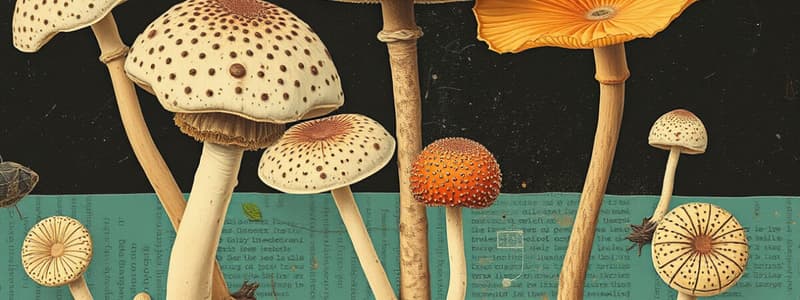Podcast
Questions and Answers
What distinguishes fungi from plants primarily in their structure?
What distinguishes fungi from plants primarily in their structure?
- They are composed of hyphae. (correct)
- They contain cellulose.
- They possess chlorophyll.
- They are autotrophic.
Which of the following statements best describes why fungi are classified as eukaryotic?
Which of the following statements best describes why fungi are classified as eukaryotic?
- They lack membrane-bound organelles.
- They undergo asexual reproduction exclusively.
- They contain a nucleus and membrane-enclosed organelles. (correct)
- They have a prokaryotic cell structure.
What defines parasitic fungi?
What defines parasitic fungi?
- They reproduce asexually only.
- They require a living host for nutrition. (correct)
- They feed exclusively on dead organic matter.
- They are always beneficial to their hosts.
What is a characteristic feature of saprophytic fungi?
What is a characteristic feature of saprophytic fungi?
Which of these is considered a negative economic impact associated with fungi?
Which of these is considered a negative economic impact associated with fungi?
What is the primary role of rhizoids in rhizopus fungi?
What is the primary role of rhizoids in rhizopus fungi?
In what scenario do rhizopus fungi typically reproduce sexually?
In what scenario do rhizopus fungi typically reproduce sexually?
What is the name of the process by which yeast primarily reproduces?
What is the name of the process by which yeast primarily reproduces?
Flashcards are hidden until you start studying
Study Notes
Differences Between Fungi and Plants
- Fungi structure consists of hyphae, while plants have a different cellular structure.
- The sugar found in fungi is chitin, contrasting with the cellulose in plants.
- Fungi are heterotrophic, meaning they obtain nutrients by consuming other organisms, unlike autotrophic plants.
Eukaryotic Nature of Fungi
- Fungi are classified as eukaryotic organisms due to the presence of a nucleus and membrane-bound organelles within their cells.
Parasitic Fungi
- Parasitic fungi derive nutrients from a living host, potentially harming the host organism.
- Examples include potato blight and athlete's foot.
Saprophytic Fungi
- Saprophytic fungi feed on decomposing organic matter, playing an essential role in nutrient cycling.
- Common examples include Rhizopus (black bread mold) and yeast.
Economic Impacts of Fungi
- Negative economic effects include food spoilage, disease in crops, and timber rot.
- Positive contributions involve the production of alcohol, bread, antibiotics, and serving as a food source.
Reproduction of Rhizopus
- Rhizopus reproduces sexually under unfavourable conditions, such as drought or unsuitable temperatures, enhancing survival.
Asexual Reproduction in Yeast
- Yeast reproduce asexually through a process called budding, allowing rapid population growth in suitable environments.
Functions of Rhizopus Structures
- The stolon in Rhizopus spreads over the food surface, facilitating the growth of new mycelium.
- Rhizoids serve to increase surface area for nutrient absorption and aid in substrate digestion.
Studying That Suits You
Use AI to generate personalized quizzes and flashcards to suit your learning preferences.




